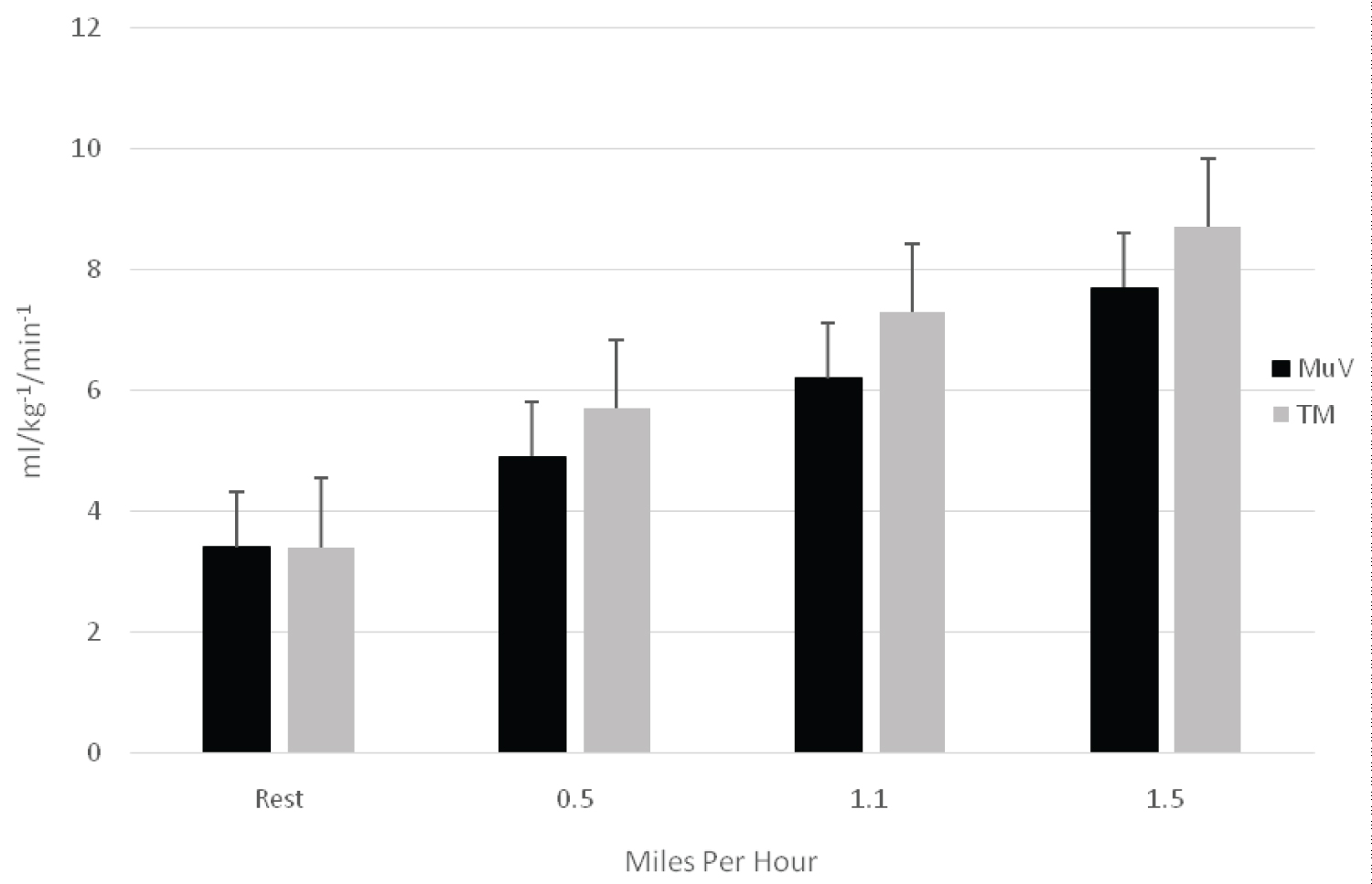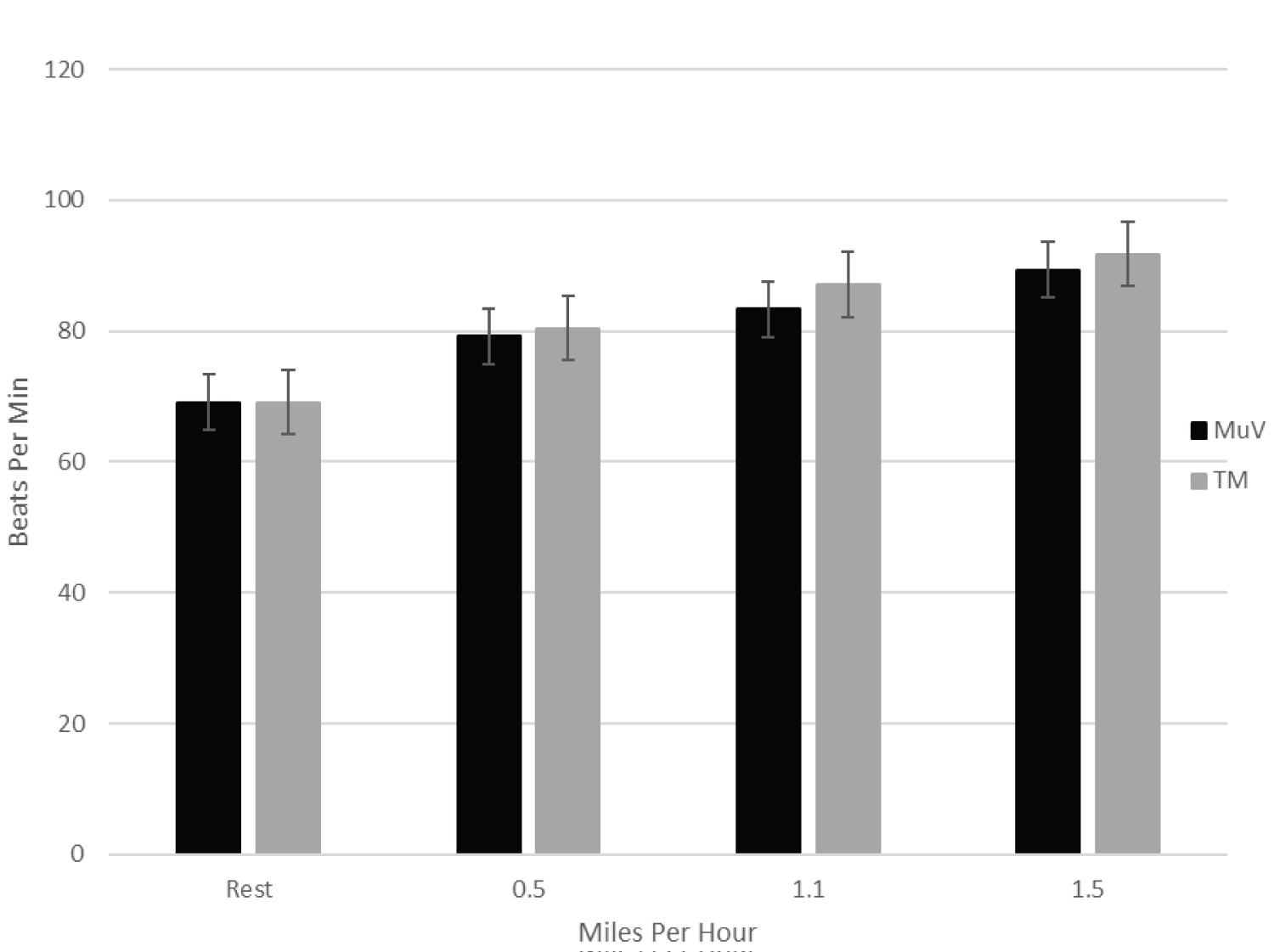Objective: The purpose of this study was to compare the Energy Expenditure (EE) during very low-speed (< 2.0 mph) treadmill walking while seated to EE during upright treadmill walking.
Design: A convenience sample cohort study of nine volunteer participants (4 males; 5 females) M age 63.4 (± 10.5) years performed both seated (MuV) and standing walking (STW), across 0.5 mph, 1.1 and 1.5 mph velocities.
Setting: Institutional, University of Oklahoma Human Performance Laboratory in Tulsa.
Participants: Elderly adults with no contra-indications for low speed walking, recruited from the University of Oklahoma staff, faculty and a local YMCA.
Main outcome measures: Differences between MuV and STW O2 Consumption (VO2), Rating of perceived exertion (RPE10), and heart rate (HR).
Results: Mean HR and VO2 differences between MuV (Seated) and STW (standing) walking at very low intensities were small but statistically significant at p < 0.05. Effect sizes were moderate to high (0.61-0.85) for VO2 at 0.5 and 1.1 mph respectively and low to moderate (0.23-0.61) for HR and RPE for 1.1 mph speed.
Conclusions: For people unable to stand or walk, the seated treadmill is a suitable alternative to an upright treadmill. Additional studies in larger and more diverse populations are required in order to confirm this studies initial findings to the general population.
Clinical relevance: This form of exercise may have value for those seeking very low intensity (subliminal) exercise while seated at a desk or for those individuals who have a low orthopedic tolerance.
Treadmill walking, Seated walking, O2 consumption, Rating of perceived exertion
For many people who are unable to jog or run, walking is a viable substitute for cardio/pulmonary and leg strengthening exercise. Hindrances to walking, however, such as lower extremity weakness, neuromuscular disorders and vision impairment effect many people. Others have vocations that require sitting at a desk or table for most of the workday are at risk for the negative health effects of inactivity [1-3]. Prolonged sitting has been associated with an increased risk of cardiovascular events [4-6] and may be considered the "New Smoking" [7]. Excessive sitting is positively related to the development of type II diabetes and a major contributor to the high rates of obesity in the general population [8,9]. Some corporate wellness programs permit desk workers and others to work while walking on a low-speed treadmill [5]. Standing desk treadmills are the most popular among participants. However, several drawbacks have limited the wide acceptance of the standing machines including comfort, cost, and size [2,10]. The MuV is a small low speed seated treadmill is designed to fit under a work surface or desk. This study examines the physiological differences between seated treadmill and standing walking across three pre-determined walking speeds, 0.5 mph, 1.1 mph and 1.5 mph.
This pilot study compared very-low speed walking while sitting (MuV) to very-low speed walking while standing (STW). The Energy Expenditure (EE) of nine physically active adults (4 males and 5 females), were measured, and compared.
Physiological variables included Heart Rate (HR), Expired Air (VO2), Cadence (CAD) and Rating of Perceived Exertion (RPE10). Hypothesis: Energy Expenditure (EE) during MuV™ and STW walking will not be significantly different (p < 0.05) across three walking velocities (0.5 mph, 1.1 mph and 1.5 mph).
A small convenience sample of four physically active males and five physically active females (M = 63.4 (± 10.5) years of age, was recruited from University of Oklahoma Health Sciences Center students, physicians, employees and Tandy YMCA staff and members. This study was approved by the University of Oklahoma Institutional Review Board. Exclusion criterion included; 1) Any yes response on the Physical Activity Readiness Questionnaire (PAR-Q) [11], or 2) Any cardiac, pulmonary, or musculoskeletal contraindications to exercise. All participants were injury free for the past 3 months, and had previous experience walking on a motorized treadmill.
Physiological measures for EE included VO2 (ml/kg-1/min-1), Heart Rate (HR) (beats/min), Cadence (Steps/minute-1) and a subjective Rating of Perceived Exertion (RPE10) for both lungs and legs. Metabolic rates were determined by indirect calorimetry using a computerized metabolic system (Parvo Medics, TrueOne 2400, Sandy, UT, USA). Samples of expired gases were collected during walking while sitting and standing. Collection occurred through a one-way breathing valve and tubing that directed flow first through a pneumotach for measurement of volume flow rates, and then into a mixing chamber. Rates of oxygen uptake (VO2) and were determined from the average value during the minute of each five-minute trial. Standing walking tests were performed on a calibrated motorized treadmill (STW). S seated walking was performed on a calibrated MuV™ mini-treadmill. These measures have shown in the past to be stable and reliable variables to compare energy expenditure specifically for walking or running energy expenditure [12-15]. This study compared the individual EE differences between seated walking (MuV) and upright walking (STW). Paired T-Test were performed along with an Omnibus ANOVA. The minimum alpha significance level was set at 0.05. In order to conduct a power analysis, Cohen's d-statistic values for small (0.40), moderate (0.60), and large (0.80) effects were calculated [16].
Participants were randomly assigned to one of two groups to control for the ordering effect. After a 2-3- minute warm-up/familiarization at a self-selected pace.
Group 1 performed the seated treadmill walking stages first followed by standing treadmill walking. Group 2 began with STW (standing) walking and then performed the MuV walking test. Variables were recorded the last 30 each stage. The test protocol for each group was as follows:
Group 1
Activity Speed Duration
Seated walking Familiarization 0.5-1.0 mph 2 min
Seated walking Stage 1 0.5 mph 4 min
Seated walking Stage 2 1.1 mph 4 min
Seated walking Stage 3 1.5 mph 4 min
Seated recovery Rest 0.0 mph 2 min
Standing walking Stage 1 0.5 mph 4 min
Standing walking Stage 2 1.1 mph 4 min
Standing walking Stage 3 1.5 mph 4 min
Standing recovery Rest 0.0 mph 2 min
Group 2
Standing walking Stage 1 0.5 mph 4 min
Standing walking Stage 2 1.1 mph 4 min
Standing walking Stage 3 1.5 mph 4 min
Standing recovery Rest 0.0 mph 2 min
Seated walking Familiarization 0.5-1.0 mph 2 min
Seated walking Stage 1 0.5 mph 4 min
Seated walking Stage 2 1.1 mph 4 min
Seated walking Stage 3 1.5 mph 4 min
Seated recovery Rest 0.0 mph 2 min
Four males and five females, mean Age 63.4 (± 7.41), BMI 32.1 (± 10.5), performed MuV and STW portions of the graduated walk test. Assumptions for normal distribution and homogeneity of variance (α > 0.05) for VO2, HR, CAD, age and BMI were met. MuV and STW means (± SD) across three walking speeds of 0.5 mph, 1.1 mph and 1.5 mph were calculated for VO2, HR, RPE and Cadence mean values and standard deviations are presented in Table 1.
Table 1: Resting and Walking Mean, (± SD) VO2, Heart Rate and Cadence for seated (MuV) and standing (TM) Treadmill Walking. View Table 1
Observed differences in O2 consumption (VO2) between MuV and STW walking were small. Seated (MuV) VO2 at 0.5 mph was slightly less than STW at 0.5 mph, Mean difference = - 0.92 ml/kg-1/min-1 (± 1.0) (CI 95% -1.71, -0.80), t (1,8) = -2.54, p < 0.05 (ES 0.85) as well as 1.1 mph velocity, mean difference = -1.13 ml/kg-1/min-1 (± 1.2), (CI 95% -2.12, -0.13), t (1,8) = -2.61, p < 0.05 (ES 0.87). At 1.5 mph, VO2 for MuV walking was slightly lower than STW walking, and was not statistically significant, mean difference = -0.965 ml/kg-1/min-1 (± 1.54), (CI 95% -2.14, 0.23), t (1,8) = -1.85, p > 0.05 (ES 0.72). Figure 1 compares mean resting VO2 (3.46 ml/kg-1/min-1) with VO2 for both MuV and STW conditions across the three designated walking velocities. When compared to resting values, O2 consumption was significantly greater (p < 0.001) for both MuV, mean 4.8 (± 0.53), 6.2 (± 0.90), 7.7 (± 0.53) ml/kg-1/min-1 and STW conditions, mean 5.7 (± 1.05), 7.3 (± 1.28), 8.7 (± 1.59) ml/kg-1/min-1 across 0.5, 1.1 and 1.5 mph walking speeds respectively (Figure 2).
 Figure 1: Mean VO2 and SEE for MuV and TM walking. View Figure 1
Figure 1: Mean VO2 and SEE for MuV and TM walking. View Figure 1
 Figure 2: Mean Heart Rate and SEE for MuV and TM walking. View Figure 2
Figure 2: Mean Heart Rate and SEE for MuV and TM walking. View Figure 2
Heart Rate (HR) for MuV at walking speeds of 1.1 mph was significantly less than STW mean difference = -3.7 beats/min (± 3.4) (CI -6.4, -1.1), t(1,8) = 3.28, p < 0.05 (ES 0.61). HR for STW walking at 1.5 mph was lower for MuV compared to STW and was statistically but not clinically significant, Mean difference = -3.7 beats/min (± 3.4) (CI -6.4, -1.1), t(1,8) = -2.56, p < 0.05 (ES 0.39) (See Table 2). When compared to resting HR, walking HR values were significantly greater (p < 0.01) for both MuV, mean 10.1 (± 6.8), 14.2.2 (± 7.7), 20.2 (± 8.8) beats/min-1 and STW conditions, mean 11.3 (± 8.7), 18.0 (± 7.7), 22.7 (± 7.8) beats per/min-1 across 0.5, 1.1 and 1.5 mph walking speeds respectively.
Table 2: Mean Differences, SD, CIs and effect size between MuV and TM for O2 Uptake (VO2) in ml/kg-1/min-1, Heart Rate (HR) beats/min, Rating of Perceived Exertion (RPE10) and Cadence (CAD) steps/min. View Table 2
There were no statistically significant differences between MuV and STW conditions for Rating of Perceived Exertion (RPE) (p > 0.05) for both lungs and legs across all three walking velocities. No significant differences in cadence were found between MuV and STW conditions for 0.5 and 1.1 mph walking speeds (p > 0.05). However, higher cadences were observed for MuV condition at 1.5 mph speeds when compared to the STW condition and these differences were statistically significant, mean difference = 14.5 steps/min (± 17.7) (CI 0.94, 28), t(1,8) = -2.47, p < 0.04 (ES 0.82).
At very low intensities energy expenditure (HR and VO2) for standing walking was slightly higher than seated walking and were statistically significant (p < 0.05). Effect sizes were moderate to high for VO2 at 0.5 and 1.1 mph respectively and low to moderate for HR and RPE at 1.1 mph. These findings align with results reported by previous studies. Wang, et al., 2018 explored the difference between resting seated and standing energy expenditure and reported a 16.8% greater mean VO2 for standing (M = 4.04 ± 0.38 ml/kg-1/min-1) resting energy when compared to resting VO2 for sitting (M = 4.72 ± 0.42 ml/kg-1/min-1) p < 0.01 [3]. Ludlow, et al. also reported modest differences between with mean VO2 measures of 3.16 ± 0.08 ml/kg-1/min-1 and 3.51 ± 0.08 for seated and standing values respectively [17].
For this current study, VO and HR values were statistically higher across 0.5, 1.1 and 1.5 mph walking for both MuV and STW conditions when compared to resting values. Higher cadences observed for the MuV condition compared to the standing 1.5 mph walking speeds is likely due participants adopting a shorter stride pattern in order to accommodate the higher treadmill velocity. Seated treadmill walking (MuV) may have value for those seeking "subliminal exercise" while seated at a desk or for those individuals who have a low orthopedic tolerance or other disabilities preventing them from walking while standing. This current study should guide future, cohort studies in order to determine if MuV walking at very low intensity levels would be a valid surrogate for low-intensity treadmill walking. Additional research should focus on developing appropriate walking speeds for "subliminal exercise" in larger more diverse populations.
The authors acknowledge the technical support of On the MuV™ and for suppling seated treadmills used in this study. There are currently no conflict of interests associated with the authors and On the MuV™.